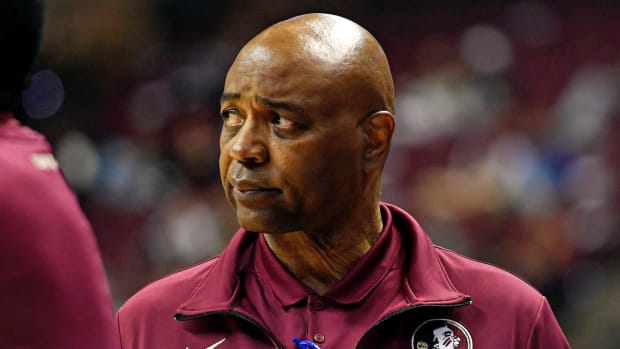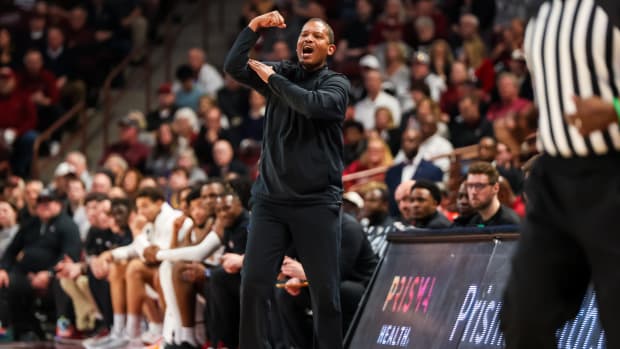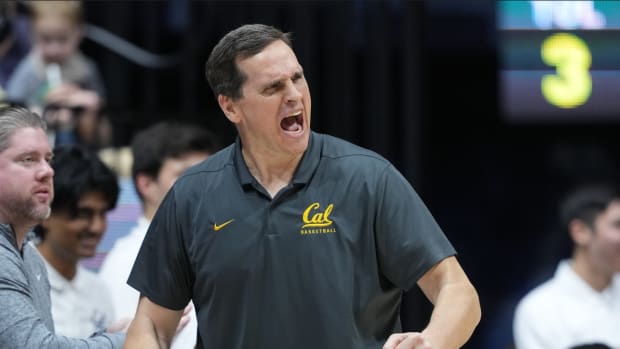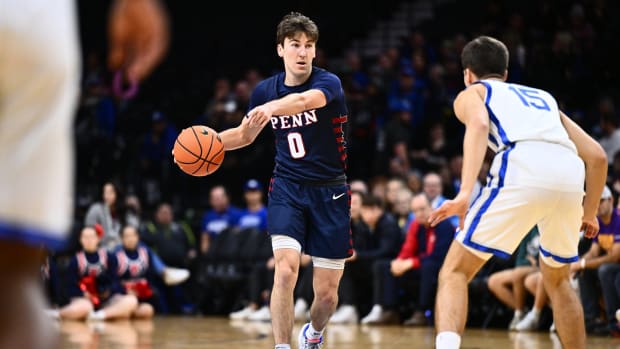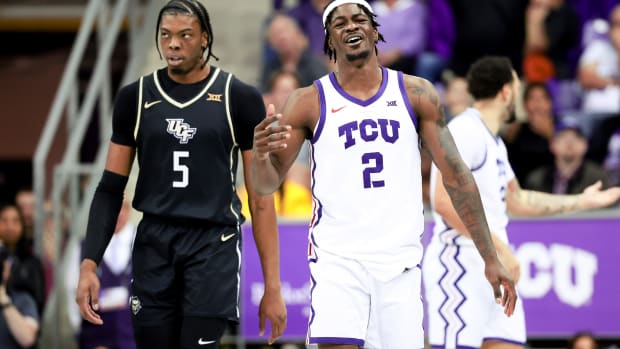The 10 Teams Most Likely to Win the 2021 Men's National Title
The fun part of filling out an NCAA tournament bracket is plotting early upsets and seeing what carnage may unfold. But let’s be honest, the money is at the end: you need to pick the winning team. With that in mind, here are the 10 teams* that have a chance of climbing the Werner Ladder on the night of April 5 in Indianapolis and cutting down the nets. Interestingly, the quartet at the top of the list all would be first-time national champs.
(*I’m not sure 10 teams really have a great chance. But it’s a nice, round number, so that’s what we’re going with.)
1. Gonzaga
Seeding: No. 1 in the West Region, and No. 1 overall
Record: 26–0
Pomeroy (KenPom) Rating: No. 1 by 5.83 points over No. 2 Michigan, which is Pomeroy's largest spread between first and second in his 19-year history of published rankings
Best tournament finish: runner-up in 2017.
This is the No. 1 offensive efficiency team in the nation, and that generally foreshadows a deep run. Of the last five NCAA tournament teams that had the top offense, one won the national championship (Villanova 2018), two others made the title game (North Carolina 2016 and Wisconsin 2015), and one made the Elite Eight (Gonzaga 2019). Only Oklahoma State 2017 was an early out, largely owing to a terrible defense. Gonzaga has the high-end talent, the experience, the coaching and the focus needed to win six straight games. When the Zags have played elite competition this season they’ve dominated, decisive victories over Kansas, West Virginia, Iowa and Virginia. And the West Region doesn’t present much of a challenge.
The burden of being undefeated and the false security of having their way with a middling conference are concerns. But being down 14 in the West Coast Conference title game to a good BYU team might have been exactly what Gonzaga needed to shake off complacency and to feel the pressure of having to execute in a tighter-than-usual situation.
MORE: Who Are Gonzaga's Toughest Obstacles to a Perfect Season?
2. Illinois
Seeding: No. 1 in the Midwest Region
Record: 23–6
Pomeroy Rating: No. 3
Best tournament finish: runner-up in 2005.
The Illini have all the pieces. In Ayo Dosunmu they have a multi-use star who tends to shine brightest in late-game situations. In 7-foot, 280-pound Kofi Cockburn they have a powerhouse in the paint who uses his core strength to devastating effect at both ends of the floor. In freshman point guard Andre Curbelo they have someone who can break down defenses to score or distribute. In Trent Frazier, Adam Miller, Giorgi Bezhanishvili and Da’Monte Williams, they have role players capable of contributing double figures against the best competition.
The concern is a tendency to float at times, taking a few possessions off defensively or throwing the ball away on offense. That’s what got Illinois into some tight situations against the dregs of the Big Ten, Nebraska and Northwestern. While nobody goes into a single-elimination tournament lacking motivation, sometimes the habits of a season can still come back to haunt a team. And with a tough draw in the second round (Georgia Tech or Loyola Chicago) and potentially the third (Oklahoma State), Illinois has to be on its game all the time.
3. Baylor
Seeding: No. 1 in the South Region
Record: 22–2
Pomeroy Rating: No. 4
Best tournament finish: runner-up in 1948
The Bears are the Joe Frazier of the hardwood—a resolutely tough bunch that can absorb punch after punch and keep coming, finally breaking the opponent’s will. This is the second full season together for 75% of the eight-man rotation, with Jared Butler and Mark Vital playing together for three years. In today’s transient world, that’s a lot of continuity. Baylor has long hung its hat on defense, but this group has evolved into an elite offensive unit that leads the nation in three-point shooting percentage (.418). It’s not out of the question that the Bears could get on a three-point roll like Villanova 2018 and simply shoot everyone in their path out of the tournament.
The question is whether Baylor lost a little of its vicious edge during a three-week COVID-19 pause in February. The Bears went into it 17–0 and came out of it 5–2. The losses are hardly bad (Kansas and Oklahoma State), but this was a team dominating the Big 12 up to that point. The Jayhawks did expose short-ish Baylor on the backboard, which presents a potential issue if the Bears meet North Carolina in the Round of 32.
4. Alabama
Seeding: No. 2 in the East Region
Record: 24–6
Pomeroy Rating: No. 8
Best tournament finish: regional runner-up in 2004
Nate Oats’s up-tempo, threes-and-layups attack has taken the Southeastern Conference by storm, and could carry over a long way in this tournament. Especially when combined with a defense that is second-best in the nation, limiting opponents at the three-point line and turning them over. Combine that with the fact that the top seed in the East, Michigan, likely is missing one of its key players for at least the first two rounds and perhaps the entire tournament. The opportunity is there for the Crimson Tide, which weathered a couple of serious battles in the SEC tourney.
Unfortunately, Bama is likely without energetic 6’ 6” wing Joshua Primo for at least one round and likely longer after he sprained an MCL in the quarterfinals in Nashville. That takes away one three-point threat and some length on the defensive end. Alabama will also need to keep guard Jahvon Quinerly playing the way he did in the SEC tourney, where he took good shots and took care of the ball. He’s had some games where decision making is an issue.
Sign Up to Play SI's Bracket Challenge and Compete For a Chance to Win Prizes.
Create Your Group Now | Official Rules
5. Oklahoma State
Seeding: No. 4 in the Midwest Region
Record: 20–8
Pomeroy Rating: No. 30
Best tournament finish: national champions in 1945 and ’46
The ceiling for this team is high enough that the comparison is to the 2003 Syracuse team that rode freshman mega-talent Carmelo Anthony to the national title. Cade Cunningham is the man trying to fill the Carmelo role this time around—the likely No. 1 pick in the draft, a 6’ 8” point forward who can score 20 while also creating for his teammates. Oklahoma State is flush with athletes and playing very confidently under coach Mike Boynton. The Pokes also have improved defensively as the season has progressed. The efficiency numbers don’t mark them as elite, but nobody in the field will want to play them.
The draw is difficult, with Oklahoma State on a collision course with Illinois in the Sweet 16. Combating 280 pounds of Kofi Cockburn could be difficult there. But first, the young Cowboys have to show they can handle NCAA tournament pressure—none of them, including Boynton, has ever been there, and veteran first-round opponent Liberty has. Valuing the basketball, as the coaches say, will be important.
6. Florida State
Seeding: No. 4 in the East Region
Record: 16–6
Pomeroy Rating: No. 15
Best tournament finish: runner-up in 1972
The Seminoles have shooters, size, toughness, tourney experience, a lottery pick point guard and a coach who is overdue to make a Final Four. Leonard Hamilton has knocked on the door in recent years, making the Sweet 16 in 2019 and Elite Eight in ’18, and last year’s time certainly had the look of a Final Four team. Now he could also have the draw to make it to the last weekend, landing in Michigan’s region.
Balsa Koprivica’s late rise gives Hamilton a 7-footer that improves rim protection and paint production; M.J. Walker provides the perimeter shooting; and 6’ 9” point guard Scottie Barnes is the matchup nightmare. Barnes also turns the ball over a fair amount, as do the Seminoles in general—their turnover rate is higher than all but 11 teams in the field, including coughing it up 25 times in the ACC tournament final. And while balance is nice, it also means FSU may lack a go-to scorer in a game where buckets are hard to come by.
7. Arkansas
Seeding: No. 3 in the South Region
Record: 22–6
Pomeroy Rating: No. 18
Best tournament finish: national champions in 1994
Until losing a tough battle with LSU in the SEC tournament, the Razorbacks were one of the hottest teams in the country. They had won nine straight, including successive victories over NCAA teams Missouri, Florida, Alabama and LSU. Eric Musselman has a first-round NBA talent in freshman shooting guard Moses Moody and an array of transfers around him. Arkansas is very comfortable playing fast at both ends, with the athletes to lock down defensively and run the floor offensively.
The Hogs would benefit from a re-emergence of 7’ 3” sophomore Connor Vanover, whose playing time decreased at season’s end. He gives Arkansas a different element that can be valuable at tournament time, when the ball tends to wind up in the paint more often. Avoiding gobs of turnovers also will be important for a team that committed 15 or more in five of their six losses.
8. Ohio State
Seeding: No. 2 in the South Region
Record: 21–9
Pomeroy Rating: No. 7
Best tournament finish: national champions in 1960
If any team should flourish upon departure from conference play, it’s the Buckeyes. They’re a very good team that was a bit beaten down by the end of the regular season, losing their last four to good competition, then righted themselves in the league tourney and reached the final. Once there, they pushed Illinois into overtime. Chris Holtmann’s team can score in a lot of ways, from the streaky perimeter shooting of Duane Washington Jr. to the deceptive inside game of E.J. Liddell and everything in between. The taste of success in Indianapolis in the Big Ten tourney may well carry over to a deep run in the Big Dance.
Ohio State would certainly benefit from a return of muscly forward Kyle Young from a concussion that kept him out of the last two games in the Big Ten tourney. The Buckeyes need every thick and large body they can get, because they’re undersized and vulnerable defensively. There also is a concern about late-game decision making in terms of getting the right shots from the right people in the right places on the court.
9. Texas
Seeding: No. 3 in the East Region
Record: 19–7
Pomeroy Rating: No. 26
Best tournament finish: Four Four appearances in 1943, ’47 and 2003
The Longhorns check most of the boxes you want in searching for a national champion. Experienced guards: check. Length: check. Athleticism: check. A coach with Final Four experience: check. Add in the confidence that comes with winning the Big 12 tournament title with a pair of hang-tough victories over Texas Tech and Oklahoma State. After a 4–6 stretch from mid-January through the end of February, Texas came into March with a new bounce and a new resolve. Winning five straight away from home is a nice springboard into this tourney.
There remains some question about who the team’s alpha dog should be. Three different guards can play that role in Andrew Jones, Courtney Ramey and Matt Coleman, but roles sometimes do not seem clearly defined. And then there is the issue of Greg Brown, the five-star freshman who has had some great moments but also walked off the bench during the Big 12 tournament and might have played himself down to a severely diminished place in the rotation.
10. Michigan
Seeding: No. 1 in the East
Record: 20–4
Pomeroy Rating: No. 2
Best tournament finish: national champions in 1989
If Isaiah Livers doesn’t come back from a stress injury in his foot, how far can the Wolverines go? With him, they’d be in the top three or four on this list. Without him, well, here we are. Livers said this week, “If I do (return), that’s miraculous.” So set your expectations accordingly.
Still: this is a team with a lot of assets, starting with Hunter Dickinson—a 7-footer who doesn’t want to waste time floating around the perimeter. He’s paired with a first-round talent in 6’ 9” Franz Wagner, and a short but resourceful backcourt that should not be underestimated based on how they look in the layup line. Juwan Howard has more than proven his coaching chops this season, but he’s got a big chore ahead of him in this tournament if his 13-point, 6-rebound, 2-assist senior leader cannot play.
Five longer shots with a chance: Georgia Tech, Loyola Chicago, Oregon, LSU, North Carolina.
SI’s tournament newsletter analyzes everything you need to know about the Big Dance: what just happened and what’s happening next. Sign up for Morning Madness here.

